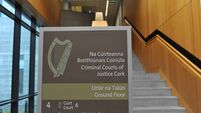Only 4% of women targeted by online sexual harassment report it to gardaí, research shows

281 women who responded to a questionnaire said they had experienced cyber-based forms of sexual violence.
Just 4% of women targeted by online sexual harassment and abuse would report the matter to gardaí, despite the introduction of Coco’s Law, according to new research.
The research has been carried out by Lorraine Hayman of the Centre for Global Women’s Studies at the University of Galway. It focuses on cybersexual violence.
She began researching the topic in Ireland in 2022, and 281 women who responded to a questionnaire said they had experienced cyber-based forms of sexual violence, she said.
However, despite 42% of women saying their mental health was impacted, just 3% said they would go to sexual violence and rape services for support, while just 4% said they would report such an incident to gardaí.
Ms Hayman described the figures as “really, really low” and said while some women told her they had tried to report such incidents to gardaí, there appeared to be confusion about whether or not such material was illegal.
She pointed out the area was covered legislatively by both Coco’s Law and the Online Safety Media Regulation Act. Coco’s Law was enacted in 2021, and criminalises the sharing of, or threatening to share, intimate images without a person’s consent, with or without intent to cause harm to the victim.
There have been a number of recent court cases prosecuted under Coco’s Law.
Ms Hayman, whose research is funded by Research Ireland, will speak at the Law, Sexuality and Gender conference in Liverpool on Thursday about her findings.
Of the 281 women who said they had been targeted by cyber-based sexual abuse:
- One was aged 75 and had been the victim of cyber flashing;
- The majority were aged between 18 and 24 years;
- 64% were targeted by somebody commenting online or sending them private messages about unwanted sexually explicit comments, threats and sexual requests. 78% of those experienced it by private message on social media;
- 54% knew the perpetrator, while 40% said they were targeted by strangers;
- 71% experienced cyber flashing by private message on social media;
- 30% reported they blamed themselves for what happened;
- 42% of respondents said their mental health was impacted.
Ms Hayman said cybersexual violence includes image-based sexual abuse such as cyber flashing, and sharing or creating or threatening to create and share what were considered private intimate images. However, she said it also included manipulation of images, as well as written abuse.
“I have also seen things like the manipulation of images — not only by AI, which we would refer to as deep fake. But also I have seen more crude methods like using photoshop for example and manipulating an image to look a certain way, depicting the victim survivor doing something sexual that they didn’t do.
"Cyber stalking has also come up. My work also looked at written forms — receiving unwanted sexual solicitations, sexual requests, sexual threats like rape threats. The most commonly experienced one is the written form.”














